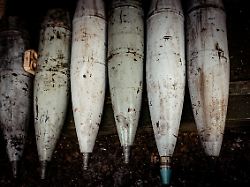Old stocks are also running out
Russian ammunition production cannot keep up
February 21, 2024, 5:18 p.m
Russia has enormous military resources. But they too are finite. This is what Western experts have determined. Currently, enough ammunition can still be made available for the invasion of Ukraine, but domestic production is already showing gaps. Russia doesn’t have many alternatives.
According to representatives of Western countries, Russia is producing too little ammunition for its army in the Ukraine war. “Russia’s domestic munitions production capacity is currently insufficient to meet the needs of the Ukraine war,” said Western officials, who did not want to be named. The recent withdrawal of the Ukrainian army from the city of Avdiivka made it very clear that the availability of ammunition or the lack of it is crucial.
A similar assessment was recently made British military experts Jack Watling and Nick Reynolds from the Royal United Services Institute (RUSI). After 2026, “Russian combat power will decline significantly” and Russia’s industry could be sufficiently impaired as a result of material warfare by then that “Russia’s prospects for success will worsen over time,” they wrote in a commentary.
According to their findings, the Russian Ministry of Defense has calculated a need for around 5.6 million shells of 152 millimeter and 122 millimeter caliber for 2024. However, the industry assumes that it will only be able to produce 2.1 million shells of the required calibers. Russia would therefore have to resort to stocks that would be in poor condition. In addition, grenades and weapon systems are imported, for example from North Korea. However, even the two million 122-millimeter shells from Pyongyang would not be enough to close the gap, experts said. They assume that Russian production of all types of artillery shells will level off at three million pieces per year, which will not be enough in the long term.
Western sanctions are working
In addition to imports from North Korea, there are deliveries from Iran. At the beginning of the invasion, he sent numerous kamikaze drones to the Russian military. According to Reuters, 400 surface-to-surface ballistic missiles also recently arrived from Tehran. These should have a range of 700 kilometers.
The Russian defense industry would feel the effects of sanctions, say Western experts. Because Russia cannot rely on Western components, it is more difficult for it to produce new systems and repair old ones. “The sanctions hit the Russian military industrial sector hard, causing significant delays and increasing costs,” the Western officials said.
However, the Russian army will sooner or later reach its limits, not just in terms of ammunition. The high losses are also becoming more and more noticeable in tanks, armored vehicles and other military equipment – and replacements will become increasingly difficult to obtain. According to the independent Dutch portal Oryx The Russian army has lost at least 2,754 tanks since the invasion began. There are also more than 5,000 infantry fighting vehicles as well as armored troop transports and hundreds of fighter jets and helicopters.
Russia still needs thousands of tanks
According to Watling and Reynolds, Russia issues around 1,500 tanks and around 3,000 armored vehicles to the armed forces every year. However, around 80 percent of the tanks and armored vehicles are outdated and modernized stocks. These reserves would allow Russia to maintain consistent deliveries until the end of 2024. However, a large part of the stocks will be used up by 2026.
And the Russian military continues to need military equipment and vehicles on a large scale. Colonel Markus Reisner explained in an interview with ntv.de that around 500,000 Russian soldiers are currently deployed in Ukraine. They had a total of around 3,000 tanks, 7,000 infantry fighting vehicles and around 5,000 artillery systems. In doing so, Russia will try to “cause a breach of the dam,” said Reisner. However, previous successes, such as in Avdiivka or Bakhmut, were always bought at great material losses. Moscow will then have to make up for this again and again, which will become increasingly difficult due to falling inventories and sanctions.
